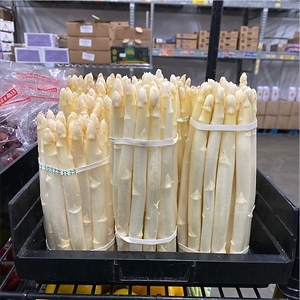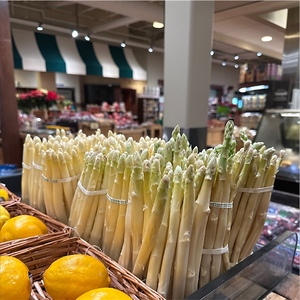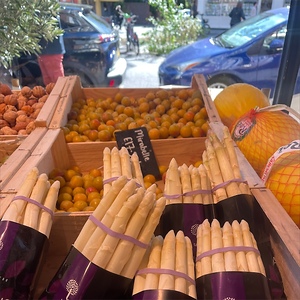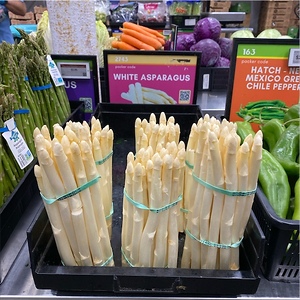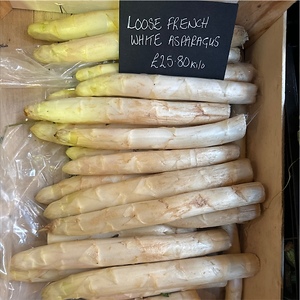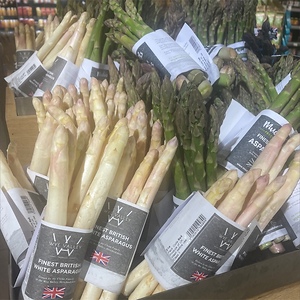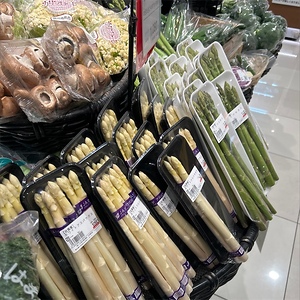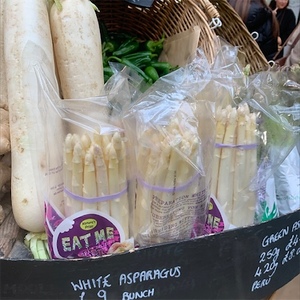


White Asparagus
Estimated Inventory, 11 lbs : 0
Description/Taste
White asparagus is a long, pearly-white vegetable that grows in stalks. It can reach lengths of 20 to 25 centimeters, with its diameter varying according to cultivation methods. The slimmest varieties resemble pencils, boasting ultra-slim, knobby stalks about 3 millimeters in width, while the thicker variants can reach diameters up to 22 millimeters. Characterized by smooth stalks and distinctive, cruciferous, tree-shaped tips, White asparagus’ color is not purely white but a subtle shade of pale cornflower yellow, enveloped in ivory-white flesh. The flesh itself is notably crisp and snappy. White asparagus emits a subtle aroma, more understated than its green counterpart, with a delicate, mildly earthy, and sweet scent. The taste of White asparagus is watery and crunchy, unveiling inherently sweet and nutty flavors with hints of almond and pine nuts, alongside a subtle grassiness and hint of bitterness, contrasting with the more pronounced grassy and earthy tones of common asparagus.
Seasons/Availability
White asparagus is available in the mid-spring to early summer.
Current Facts
White asparagus, botanically recognized as Asparagus officinalis and belonging to the lily family, is a specialty crop cultivated using a growing method distinct from green or purple varieties. The spears are enveloped in mounds of soil, known as ‘hillings,’ a method that blocks sunlight and inhibits photosynthesis, thus preventing the development of chlorophyll. This careful practice ensures the spears remain pale and delicate. Harvesting occurs when the tips just begin to emerge from the earth, capturing the essence of their tender, unexposed flesh. White asparagus is produced in the Mediterranean countries of southern Europe as well as select areas in northern Africa and western Asia. Cultivated for thousands of years, White asparagus was initially prized for its medicinal qualities, especially its diuretic properties. Gradually, its culinary value came to the forefront, with White asparagus becoming a valued ingredient in European cuisine.
Nutritional Value
White asparagus is enriched with antioxidant properties attributed to its phenolic acids and flavonoids. With a composition of 93 to 95% water, it’s both low in calories and rich in nutrients. White asparagus contains B vitamins, including folate and vitamin A, supporting immune function and vision. Its dietary fiber supports digestive well-being, while its minerals—iron, niacin, phosphorus, and calcium—play crucial roles in blood production, energy conversion, and bone and teeth health.
Applications
White asparagus can be eaten raw or cooked, although its fibrous exterior typically requires peeling of the bottom two-thirds to tenderize the stalks and enrich the flavor when cooked. Due to its cultivation method, it may require thorough cleaning compared to its green counterpart. White asparagus adapts well to a variety of cooking methods, including steaming, roasting, baking, and sautéing, making it a suitable substitute for recipes that call for green asparagus. Incorporate whole spears of White asparagus into crudité platters or mix chopped or shaved spears into salads. Traditional European recipes feature simmered White asparagus spears accompanied by melted butter or hollandaise sauce. German restaurants offer steamed White asparagus, either warm or chilled, often accompanied by pfannkuchen, thin crepes served with hollandaise sauce. White asparagus pairs well with spring produce like morel mushrooms, green garlic, wild ramps, fennel, leeks, young lettuces, and citrus. Complementary ingredients such as olive oil, aged cheeses like pecorino, meats like bacon and prosciutto, cream, eggs, butter, shallots, and herbs, alongside yeasty bread and grains, enhance its flavors. To maintain freshness, store White asparagus dry or refrigerated for up to 10 days, ideally wrapped in a damp cloth or within a moist container.
Ethnic/Cultural Info
Renowned for its White asparagus cultivation, the Alsace region in France celebrates this heritage through the Confrérie de l'Asperge, or the Brotherhood of Asparagus, established in 1985 in Village-Neuf. Nestled in the Haut-Rhin department along the Rhine River and bordered by Germany and Switzerland, Village-Neuf becomes the focal point of asparagus festivities. Each year in early April, the Brotherhood orchestrates the ‘premier piquage,’ marking the season's inaugural White asparagus harvest. Just across the Rhine in Germany, the advent of ‘Spargelhof’ or asparagus houses heralds the season, showcasing White asparagus in a variety of dishes.
Geography/History
White asparagus originates from the Mediterranean regions of southern Europe, northern Africa, and western Asia. Unlike its green counterpart, which grows both in the wild and under cultivation, White asparagus is exclusively a cultivated crop. It is primarily grown in European countries such as France, Germany, Switzerland, the Netherlands, Spain, and Greece, with Peru emerging as a leading producer in the Americas. In the United States, significant cultivation occurs along the Columbia River in Washington's Yakima Valley and other parts of the state. Ideal growing conditions include cool spring temperatures, moderate summers, and sandy soils, necessitating a specialized agricultural environment. Once a delicacy known mostly in Europe, White asparagus has gained popularity in America and can occasionally be found in farmers' markets. Its short season and demanding cultivation process contribute to its higher cost compared to green asparagus. Outside its native regions, White asparagus found in grocery stores is often canned, jarred, or pickled, though you may be able to find it at some specialty stores during peak season.
Recipe Ideas
Recipes that include White Asparagus. One
| A Sausage Has Two |
|
White Asparagus Cream Soup |
Podcast








